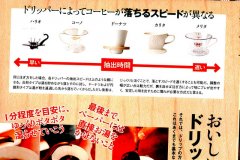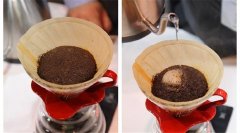4-hand coffee-making skills to make your coffee taste better

The rise of hand-brewed coffee has led to a trend of "making your own coffee". Even utensils are constantly innovating, giving coffee fans more choices. Hand-brewing coffee classrooms or coffee clubs have also been set up one by one, so it can be seen that this magic of hand-brewing coffee is still hot. Many readers are keen on hand-brewing coffee, but for some beginners, it is still impossible to accurately master the correct skills. Today, I will explain to you what you need to pay attention to when making coffee, so that you can make a good cup of coffee!
1: how fine does the coffee powder need to be ground to achieve perfect extraction?
Answer: grinding beans is the first step of handmade coffee, but it is also a step that many people are easy to fail. It is either too fine or too thick, which indirectly affects the taste of the cooked coffee powder. If you want to accurately grasp the size of the coffee powder, you can use a small flying eagle or Pegasus bean grinder, which can adjust the scale of the coffee powder and accurately grind the ideal fineness. The best thickness of hand coffee powder is between Italian coffee (No. 1 ~ 2) and French filter kettle (No. 5 ~ 6), that is, the granularity is about No. 4, and the smaller the number is, the finer the powder is. If you use a traditional hand grinder, the granularity of hand-brewed coffee is half the size of brown sugar, but the disadvantage of manual grinder is that it is easy to have uneven thickness. The coffee powder that is too fine will be over-extracted, and it is easy to extract the coffee impurities at once, while the coffee powder that is too coarse will be underextracted and the taste will be light.
2: how to handle the size of water injection when making coffee by hand? How to master the direction and speed of water injection?
A: when brewing coffee, you will first go through the "steaming stage". The time is about 15 to 30 seconds. Let the coffee powder absorb water, and the coffee powder that absorbs enough water will expand and produce another kind of aroma. The longer the coffee is steamed, the stronger the coffee flavor will be. Usually the amount of steaming water is twice that of coffee powder. For example, 30 grams of coffee powder, about pour 60cc water, so that coffee powder can absorb enough water. After stuffy steaming, the action of water injection is carried out. it is generally recommended that beginners use a fine-mouthed hand flushing pot, which is not easy to fail; at the beginning of water injection, it is easy to extract coffee, if you are an ordinary hand flushing pot, do not use too much water at the beginning, and use a large water injection near the end to avoid flushing out too many impurities. The ideal time for water injection is about one and a half to two and a half minutes. If you want the coffee to taste thicker, you can slow down. The direction of water injection can start from the center, around the outside of the circle to the clockwise direction, to remember that the biggest impact is not to rush to the filter paper. In addition, when brewing coffee, there is another technique called "cut off water", which is to interrupt the water injection process. This action can make the coffee taste not too heavy or too thin. For example, the water in 360cc can be interrupted at half the 180cc, and wait until the water level on the coffee powder drops before continuing to inject water. This can adjust the flavor of the coffee and make the taste stronger. In addition, when the water column is too large, you have to cut off the water to avoid causing the taste to be too light, so you can change the taste of the coffee and adjust the extraction rhythm through the cut-off water, which is recommended once or twice.
3: will different coffee filter cups affect the taste of coffee?
A: we have previously introduced three kinds of coffee filter cups: trapezoidal, tapered and wave filter cups, all of which may affect the taste of coffee. The biggest key lies in the speed of water flow. Due to the different design of the water guide groove, it will affect the flow rate of coffee extraction. The traditional trapezoidal filter cup has a small opening and a slow flow rate, so the coffee will taste thicker, but the disadvantage is that the flow rate may be too slow, which leads to the bitterness of stagnant water; while the tapered filter cup has large holes, the flow rate is faster, but the taste may be lighter. The wavy filter cup is because it has a flat bottom and is equipped with wave filter paper to guide the water down through the grooves on the filter paper. The water flow is the smoothest and the coffee taste is the most uniform.
4: can filter cups replace filter paper?
A: at present, there is a kind of "metal filter cup" on the market, which can achieve the effect without using filter paper, and the material of stainless steel is also quite durable. The advantage of the metal filter cup is that it can save filter paper, save money and environmental protection, and then retain more coffee oil to make the taste more rich, but also because the hole of the filter is too fine, the fine coffee powder is easy to pass through, more or less will drink some powder, it is recommended to use a powder sieve to filter the fine powder before hand flushing, so that the taste will be more dry. The recently launched KINTO "Slow Coffee Style" steel filter cup is a good choice.
Important Notice :
前街咖啡 FrontStreet Coffee has moved to new addredd:
FrontStreet Coffee Address: 315,Donghua East Road,GuangZhou
Tel:020 38364473
- Prev

Hand coffee filter cup is very knowledgeable! The devil is hiding in the velocity.
In the interview of the Japanese magazine, it is mentioned that the flow rate of several commonly seen coffee filter cups is a very interesting result, which usually does not seem to be discussed when making coffee by hand. So let's take a look at the picture above, from left to right, cooking time from fast to slow, in the following order: HARIO V60 KONO doughnut filter
- Next

Details that need to be paid attention to in hand-brewing coffee-reveal 100 points of hand-brewing coffee skills (picture and text)
The sharing from David Wang Wang Jianqiang, the certified sensory judge of the WBC World Barista Competition in China, likes to play with the speed of hand to watch. Method / step: wet the filter paper with hot water, warm the filter cup and the centimeter pot at the same time. Wetting filter paper is a key link, rough cotton paper has the smell of paper, wetting can avoid affecting the taste of coffee in the brewing process. meanwhile
Related
- Beginners will see the "Coffee pull flower" guide!
- What is the difference between ice blog purified milk and ordinary milk coffee?
- Why is the Philippines the largest producer of crops in Liberia?
- For coffee extraction, should the fine powder be retained?
- How does extracted espresso fill pressed powder? How much strength does it take to press the powder?
- How to make jasmine cold extract coffee? Is the jasmine + latte good?
- Will this little toy really make the coffee taste better? How does Lily Drip affect coffee extraction?
- Will the action of slapping the filter cup also affect coffee extraction?
- What's the difference between powder-to-water ratio and powder-to-liquid ratio?
- What is the Ethiopian local species? What does it have to do with Heirloom native species?

